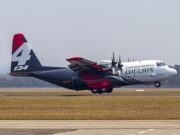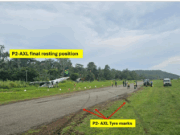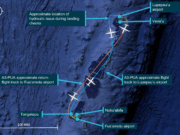
The following information provides an awareness of problems that might be avoided in the future. The information is based on final reports by official investigative authorities on aircraft accidents and incidents.
 Jets
Jets
Hot Approach, Long Landing
Embraer Phenom 300. Destroyed. Four fatalities.
Several traffic-alert and collision avoidance (TCAS) resolution advisories (RAs) were among the factors that created a high workload on approach to Blackbushe Airport in Surrey, England, the afternoon of July 31, 2015, and caused the pilot to focus on continuing an unstabilized approach to the relatively short runway, according to the U.K. Air Accidents Investigation Branch (AAIB). The pilot and his three passengers subsequently were killed when the Phenom overran the runway.
The light jet is certified for single-pilot operation, and the pilot had flown it to Milan, Italy, earlier that day to pick up three business passengers. The AAIB report said that the return flight to Blackbushe Airport was routine until the pilot entered the traffic pattern for a visual approach. During the approach, “several factors combined to create a very high workload for the pilot,” the report said. “This may have saturated his mental capacity, impeding his ability to handle new information and adapt his mental model, leading him to become fixated on continuing the approach.”
The report said that the pilot continued to monitor approach control radio transmissions while communicating on the Blackbushe flight-information frequency, which potentially served as a distraction during the approach and “had a negative impact on his situational awareness.”
While flying the downwind leg, the pilot initiated a climb to pass over a microlight aircraft ahead in the traffic pattern. Unaware of the Phenom closing from behind, the flight instructor aboard the microlight began to climb at the same time, possibly to correct his student’s descent below the proper pattern altitude. The Phenom’s TCAS sensed a conflict with the microlight and generated a series of RAs to “descend.” With the microlight in sight below, the pilot likely was confused by the advisories. Instead of complying with the RAs, he increased thrust substantially and steeped his climb to avoid the microlight.
The report said that the pilot’s confusion likely increased when the Phenom’s TCAS sensed a conflict with another light aircraft overflying the airport and generated several “maintain vertical speed” RAs followed by “adjust vertical speed” advisories.
The pilot eventually reduced thrust to idle and initiated a steep turn from the downwind leg to final approach. The Phenom’s descent rate averaged 3,000 fpm, and the aircraft’s terrain awareness and warning system generated six “pull up” warnings on final approach. Airspeed was 43 kt higher than the reference landing speed of 108 kt when the aircraft crossed the threshold of the 1,335-m (4,380-ft) runway. The aircraft touched down with 349 m (1,145 ft) of runway remaining, ran off the end at 83 kt and struck an embankment and several parked cars.
“The intensity of the [post-impact] fire meant that it was not possible to approach the aircraft to save life,” the report said. “All four occupants of the aircraft survived the impact and subsequently died from the effects of fire.”
Investigators determined that the pilot had been exposed to more than 60 “aural inputs” during the approach. “His ability to take on new and critical information, and adapt his situational awareness would have been impeded,” the report said. “In conjunction with audio overload and the mental stressors this can invoke, this may have led him to become fixated on continuing the approach towards a short runway.”
Going for a Gap
Airbus A320-211. Minor damage. No injuries.
Areas of severe weather had been forecast along the route, but they had not been considered during the development of the A320 flight crew’s flight plan or relayed in dispatch information before the crew departed from Boston on the night of Aug. 7, 2015, for a scheduled flight to Salt Lake City.
About an hour after departure, an air traffic controller advised the pilots of a large area of moderate to extreme turbulence ahead and said that they would have to deviate “significantly” to get around it, said the report by the U.S. National Transportation Safety Board (NTSB). The crew radioed a company dispatcher, who confirmed that there were thunderstorms with tops at 60,000 ft along the planned route and recommended a revised route to Salt Lake City. “According to the captain, the revised routing put them directly toward a gap in the weather that corresponded with what they observed on their weather radar,” the report said.
However, the gap in the line of thunderstorms decreased from about 30 nm (56 km) to about 10 nm (19 km) as the flight proceeded. A pilot in another aircraft that had traversed the gap told air traffic control (ATC) that it was closing and that “he did not think anybody should go through it behind them,” the report said. However, ATC did not relay the pilot report to the A320 pilots.
The crew was attempting to turn away from the thunderstorms when “the flight then began to encounter hail, which shattered the outside panes of the forward windows” and caused minor damage to the nose, wing leading edges and engine cowlings, the report said. “The captain declared an emergency and diverted to Denver International Airport.” The A320 was landed without further incident, and there were no injuries among the 124 occupants.
Hydraulic Pressure Lost
Rockwell Sabreliner 65. Substantial damage. No injuries.
The business jet was on approach to Las Vegas the evening of July 5, 2013, when the flight crew noticed a loss of pressure in the main hydraulic system. They extended the landing gear manually and continued the approach. “During the landing roll, about two-thirds down the runway, the pilots noticed that the brakes were not working normally,” the NTSB report said. Rather than attempt to bring the airplane to a stop on the remaining 3,900 ft (1,189 m) of runway, they turned onto a taxiway to clear the runway.
“The captain reported that, once on the taxiway, he was unable to stop or steer the airplane as it proceeded across a parallel runway and into an adjacent field, where it subsequently struck a metal beam,” the report said. The Sabreliner was substantially damaged, but the pilots and their four passengers were not injured. Examination of the airplane revealed no problems with the hydraulic system components, but the fluid reservoir was found to be only one-quarter full.
NTSB concluded that the probable cause of the accident was “the pilots’ failure to follow the airplane manufacturer’s emergency procedures for a hydraulic system failure and emergency braking.” Investigators found that the pilots had deviated from the procedures by not attempting to reset the electric hydraulic pump and by performing the emergency landing gear extension procedure with the auxiliary hydraulic pump engaged.
This likely “caused the hydraulic pressure in the auxiliary system to dissipate, which left only the emergency brake accumulator available for braking during the landing,” the report said. In such a case, “the number of emergency brake applications that can be made … depends on the accumulator charge, which may be depleted in a very short time.”
 Turboprops
Turboprops
Compressor Stalls on Takeoff
Saab 340B. No damage. No injuries.
The flight crew noticed no abnormal engine indications before the landing gear was retracted during departure from Ballina/Byron Gateway Airport in New South Wales, Australia, the morning of Aug. 23, 2016. “While the gear was retracting, the crew heard loud bangs, and the left engine performance degraded noticeably, reducing the climb performance,” said the report by the Australian Transport Safety Bureau (ATSB). “The crew also noticed that the left engine instruments were fluctuating rapidly and indicating a high inter-turbine temperature. A cabin crewmember advised the flight crew that passengers could see flames coming from the left engine.”
The pilots identified the problem as a compressor stall and completed the prescribed emergency procedures. “This included reducing the power on the left engine and setting maximum continuous thrust on the right,” the report said. The crew declared an urgency and returned to the departure airport, where the Saab was landed without further incident. None of the 25 occupants was injured.
Examination of the engine confirmed that a compressor stall had occurred. “After finding no fault that may have caused the compressor stall, engineers replaced the hydromechanical unit [which feeds high-pressure, metered fuel into the combustion section] in accordance with the manufacturer’s fault isolation procedure,” the report said.
Nose Wheel off Center
Viking Twin Otter. Substantial damage. Eleven minor injuries.
The flight crew — consisting of a first officer in the final stage of training to transition as a captain and an instructor pilot serving as pilot-in-command (PIC) and occupying the right seat — likely did not confirm that the nose wheel steering lever was locked in the centered position after departing from Naha, Japan, for a flight with 12 passengers to Aguni the morning of Aug. 28, 2015, according to the Japan Transport Safety Board (JTSB).
En route, the nose wheel likely “creeped” and deflected right, the JTSB report said. On approach to Aguni, neither pilot noticed that the nose wheel was not centered because they had not completed the Before Landing checklist. As a result, the Twin Otter began to veer right on touchdown. The first officer, the pilot flying, was unable to correct the drift. The PIC applied manual braking, left rudder and differential thrust but was unable to regain directional control or stop the aircraft before it ran off the side of the runway. The Twin Otter was substantially damaged when it struck a ditch and the airport perimeter fence. Ten passengers and one of the three crewmembers sustained minor injuries.
Apu Fire Spreads
Antonov 12BK. Destroyed. No injuries.
En route from Stockholm the night of Aug. 8, 2013, the four-engine An-12 was landed in Leipzig, Germany, to refuel and to load cargo destined for Mineralnye Vody, Russia. The crew consisted of two pilots, a flight engineer, a navigator, a radio operator and two flight mechanics. While preparing for departure from Leipzig, the flight crew started the auxiliary power unit (APU) and then started the no. 1 engine without incident.
As the crew subsequently was starting the no. 4 engine, the copilot noticed that APU temperature was increasing and that rpm was oscillating. “A short time later, the APU fire warning indication illuminated,” said the report by the German Federal Bureau of Aircraft Accident Investigation. “The crew shut off the two already running engines and triggered the APU fire extinguisher system.”
However, this failed to extinguish the APU fire, and it spread rapidly. The PIC opened the cockpit door and saw flames in the cargo compartment. The flight engineer and the two flight mechanics obtained portable fire extinguishers and deplaned through the emergency exit in the cockpit floor. They tried and failed to douse flames emanating from the left main landing gear well. The radio operator then requested assistance from the airport fire brigade.
The first fire truck arrived about four minutes later and began spraying foam on the aircraft. The crewmembers remaining in the cockpit then deplaned through the cockpit emergency exit and retreated to a safe area. “The fire propagation was very fast and severe,” the report said. “The fire brigade could not prevent the fire from destroying the airplane.”
Due to the extent of the damage, the cause of the fire could not be determined. “It is possible that the [APU] compressor wheel had burst,” the report said. “Subsequently, flying fragments of the compressor wheel could have penetrated the APU chamber and severed fuel pipes.”
Rapid Depressurization
De Havilland DHC-8. No damage. No injuries.
While climbing through 10,000 ft during a flight from Perth, Western Australia, to Shark Bay on Aug. 7, 2016, the flight crew conducted a transition check that indicated that the cabin pressurization system was functioning normally. However, as the Dash 8 neared cruising altitude, 18,000 ft, the flight crew noted that the cabin altitude was about 12,600 ft and increasing rapidly. The pilots donned their oxygen masks and initiated an emergency descent.
“The captain made an announcement through the aircraft’s public announcement (PA) system,” the ATSB report said. “However, the announcement was muffled and distorted, and the cabin crewmember did not understand what was being said.” Realizing that the aircraft was descending, the cabin crewmember told the passengers to fasten their seat belts. However, unaware of the nature of the emergency, the cabin crewmember did not tell the passengers to use supplemental oxygen.
After descending to 10,000 ft, the flight crew found that the pressurization system was still functioning abnormally. They called the cabin crewmember to the cockpit, advised the crewmember of the situation, and returned to Perth, where the Dash 8 was landed without further incident. None of the 33 occupants was injured.
Examination of the aircraft revealed that the rapid cabin depressurization had been caused by a malfunctioning forward outflow valve. Investigators also determined that the captain’s PA announcement had been muffled because he was wearing an oxygen mask.
 Piston Airplanes
Piston Airplanes
Refueled With Jet-A
Cessna 421C. Destroyed. Four fatalities.
Before departing from Las Cruces, New Mexico, U.S., for an emergency medical services (EMS) flight the evening of Aug. 27, 2014, the pilot asked a line service technician to add 20 gal (76 L) of fuel to each wing tank. “The pilot did not specify the type of fuel,” the NTSB report said. “The pilot was present during the refueling and helped the line service technician replace both fuel caps.”
Shortly after takeoff, both engines began to malfunction. The report indicated that the engines lost power as the pilot attempted to return to the airport. The patient, two medical crewmembers and the pilot were killed when the 421 struck terrain.
Investigators found that the airplane had been refueled with Jet-A rather than 100LL aviation gasoline. The jet fuel had caused detonation (abnormal ignition) of the fuel/air mixture in the engines’ combustion chambers and the consequent loss of power.
The report noted that the line service technician had been on the job for four months and had been working alone when he inadvertently misfueled the airplane. Moreover, the fixed-base operator’s Jet-A fuel truck was equipped with a small nozzle rather than the industry-standard larger nozzle that cannot be inserted into a piston airplane’s fuel-filler ports. The report also said that the pilot’s inadequate supervision of the refueling was a contributing factor in the accident.
Fatal Ferry Flight
Piper Seminole. Destroyed. One fatality.
The pilot was conducting a ferry flight from Keflavik, Iceland, to Merritt Island, Florida, U.S., the night of Aug. 27, 2015. Since beginning the flight 21.6 hours earlier, he had had an opportunity to rest only during a 3.8-hour delay in one of the two refueling stops. Nearing the third stop on the flight — Houlton, Maine — at 0200 local time, “the pilot likely was experiencing the effects of acute fatigue, which degraded his performance, including his handling of the airplane and his decision-making,” the NTSB report said.
Houlton was reporting 1 3/4 mi (3 km) visibility in fog and a 300-ft overcast, which were substantially below the required minimums for the global positioning system (GPS) approach to the airport. Moreover, the approach was not authorized at night.
“Radar data indicated that the pilot conducted the entire approach at altitudes 300 ft to 700 ft lower than the instrument approach procedure authorized,” the report said. “Track data recovered from an on-board GPS unit depicted the airplane making ‘S’ turns back and forth across the final approach course.”
The Seminole struck trees and terrain about 2.5 nm (4.6 km) from the runway. NTSB concluded that the probable cause of the accident was “the pilot’s descent below the published minimum descent altitude in night instrument meteorological conditions without visual contact with the runway environment.” Contributing factors were “the pilot’s acute fatigue and his decision to attempt an instrument approach procedure that was not authorized at night.”
 Helicopters
Helicopters
Night Vision Impaired
Agusta A109E. Destroyed. Three fatalities.
During an EMS flight from Santa Fe, New Mexico, U.S., to pick up a patient in Tucumcari the night of July 17, 2014, the helicopter traversed a remote area with sparse ground lighting. “Due to mid- and low-level cloud cover, it is likely that no lunar or celestial lighting was available for amplification by the pilot’s night vision goggles (NVGs),” the NTSB report said. “Since the helicopter was not equipped with an infrared spotlight, only cultural light would have been available for NVG amplification.”
Investigators determined that the pilot was flying toward a highway, likely to follow the highway lights to the city, when the helicopter turned right, climbed and then entered a steep left turn and a rapid descent into a mesa near Newkirk, New Mexico. The flight nurse, paramedic and the pilot were killed. NTSB concluded that the pilot had lost control of the helicopter after inadvertently encountering instrument meteorological conditions.
‘Gross Mechanical Failure’
Robinson R44. Substantial damage. No injuries.
The helicopter was on a company training flight from Cork, Ireland, the afternoon of Aug. 18, 2014, when the pilot flying felt vibrations and received a low rotor speed warning. He declared an emergency and conducted an autorotative landing in a farm field near Ringaskiddy.
“The investigation found that the helicopter’s engine suffered a gross mechanical failure,” said the report by the Air Accident Investigation Unit of Ireland. Progressive deterioration of a bushing had caused a piston connecting rod to fracture, resulting in significant secondary damage to two cylinder barrels and the crankcase. The report noted that the engine had accumulated 2,122.9 hours and that the manufacturer’s recommended time between overhauls was 2,200 hours.
Tail Rotor Line Failes
Eurocopter AS350-BA. Substantial damage. No injuries.
The flight crew was conducting a charter flight with three passengers the morning of Aug. 4, 2014, when they felt the helicopter begin to vibrate. As the vibrations increased, the PIC decided to conduct a straight-in autorotation to an open wheat field near Saharanpur, India.
“The pilot was unable to reduce [airspeed to] the speed recommended for autorotation because of severe vibrations and hence carried out autorotation at a high speed, which resulted in damage to the tail rotor, tail boom and the structure,” said the report by India’s Directorate General of Civil Aviation. The report noted that the recommended autorotation speed is 65 kt and that the pilot conducted the autorotation at about 80 kt.
Although substantial damage resulted from the hard landing, there were no injuries. “Examination of the helicopter revealed that one of the tail rotor pitch change links had fractured, resulting in lateral movement of the tail rotor and [pre-impact] damage to the tail rotor blade, tail boom and tail cone,” the report said.
| Date | Location | Aircraft Type | Aircraft Damage | Injuries |
|---|---|---|---|---|
|
NA = not available This information, gathered from various government and media sources, is subject to change as the investigations of the accidents and incidents are completed. |
||||
| May 1 | Bogotá, Colombia | Cessna 208B | destroyed | 8 fatal |
| The Caravan, operated by the Colombian military, struck a hill while descending to land. | ||||
| May 1 | Chignik Lake, Alaska, U.S. | Cessna 208B | destroyed | 1 fatal |
| The Caravan was cruising at 3,000 ft during a cargo flight when it struck terrain near the top of a mountain. | ||||
| May 2 | Orange Springs, Florida, U.S. | Bell 206B | substantial | 1 serious |
| The JetRanger crashed after the bucket line apparently became entangled in the tail skid while loading water during a firefighting flight. | ||||
| May 3 | Colton, New York, U.S. | Piper Navajo | destroyed | 1 fatal |
| Witnesses heard unusual engine noises and saw the Navajo flying low before it struck terrain during an air taxi flight. | ||||
| May 5 | Charleston, West Virginia, U.S. | Shorts 330 | destroyed | 2 fatal |
| Instrument meteorological conditions (IMC) prevailed when the cargo airplane touched down hard and veered off the side of the runway into a wooded area. | ||||
| May 15 | Eleuthera, Bahamas | Mitsubishi MU2B-40 | destroyed | 4 fatal |
| The MU2 struck the ocean during a flight from Aguadilla, Puerto Rico, to Titusville, Florida, U.S. At press time, the pilot and three passengers had not been found and were assumed to have been killed. | ||||
| May 15 | Hakadote, Japan | Beech LR-2 | destroyed | 4 fatal |
| IMC prevailed when the airplane, a military version of the King Air 350, struck a mountain during an emergency medical services flight. | ||||
| May 15 | Teterboro, New Jersey, U.S. | Learjet 35A | destroyed | 2 fatal |
| Visual meteorological conditions (VMC) prevailed when the Learjet departed from controlled flight, struck a building and crashed in a parking lot during a circling approach. No one on the ground was hurt. | ||||
| May 17 | Toluca, Mexico | Learjet 25B | destroyed | 2 fatal |
| The Learjet struck terrain shortly after takeoff for a positioning flight. | ||||
| May 22 | Juneau, Alaska, U.S. | Airbus AS350-B2 | substantial | 4 minor, 3 none |
| Three passengers and the pilot sustained minor injuries when the helicopter struck mountainous, snow-covered terrain in marginal VMC while returning to Juneau during a sightseeing flight. | ||||
| May 25 | New Castle, Delaware, U.S. | Eurocopter EC135-PA | destroyed | 1 fatal |
| The pilot was practicing instrument approaches in IMC when the helicopter struck terrain during a missed approach. | ||||
| May 27 | Lukla, Nepal | Let 410UVP | destroyed | 2 fatal, 1 serious |
| Visibility was reduced by fog when the cargo airplane struck terrain on approach. | ||||
| May 27 | Haines, Alaska, U.S. | Piper Twin Comanche | destroyed | 2 fatal, 1 serious |
| A witness saw the Twin Comanche approach the airstrip at treetop level, bank steeply right at the end of the strip and descend to the ground. The surviving passenger told investigators that the pilot had intentionally shut down the right engine, was unable to restart it and decided to make a precautionary landing at the remote airstrip. | ||||
| May 30 | Bajura, Nepal | PZL-Mielec M28 | destroyed | 1 fatal, 2 serious |
| The pilot was killed when the Skytruck flipped over after veering off the runway on landing. | ||||
| May 30 | Balashov, Russia | Antonov 26 | destroyed | 1 fatal, 6 serious |
| An engine failure was simulated as the An-26 approached the airport during an air force training flight. The airplane then departed from controlled flight and struck terrain 150 m (492 ft) from the runway. | ||||
| May 30 | Renmark, South Australia, Australia | Cessna 441 | destroyed | 3 fatal |
| The Conquest struck terrain shortly after departing on a check flight. | ||||
| May 31 | Buenos Aires, Argentina | Cessna 421A | destroyed | 3 serious |
| The 421 crashed in a field during an emergency landing after one engine lost power on approach. | ||||
| May 31 | Manokwari, Indonesia | Boeing 737-300 | substantial | 152 NA |
| No fatalities were reported after the 737 overran the runway on landing. | ||||
| June 2 | Tampico, Mexico | Swearingen Metro 3 | NA | 2 NA |
| The Metro was on a cargo flight from Saltillo to Puebla when the flight crew conducted a forced landing at Tampico. No fatalities were reported after the Metro struck terrain near the runway threshold. | ||||
| June 3 | San Juan, Puerto Rico | Piper Aztec | destroyed | 1 fatal, 2 serious, 1 minor |
| One passenger was killed and two passengers were seriously injured when the Aztec struck a reef while being ditched in shallow water after the pilot reported an engine failure shortly after takeoff for an air taxi flight. | ||||
| June 3 | Garbaharey, Somalia | Fokker F27-600 | destroyed | 4 none |
| The right main landing gear collapsed when it struck a concrete wall on landing during a humanitarian cargo flight conducted for the United Nations World Food Program. | ||||
| June 4 | Kenosha, Wisconsin, U.S. | Robinson R22 | substantial | 1 serious |
| Witnesses saw the helicopter climb about 30 ft on takeoff before it descended and struck the ramp on its right side. | ||||
| June 7 | Andaman Sea | Shaanxi Y-8F | destroyed | 122 fatal |
| The airplane, a Chinese version of the Antonov 12 operated by the Myanmar air force, crashed in the sea during a flight from Myeik to Yangon. | ||||
| June 9 | Mountain Ranch, California, U.S. | Beech C55 Baron | destroyed | 1 fatal |
| The wreckage was found near the top of a hill four days after the Baron was reported overdue on a flight from Patterson to Columbia in California. | ||||
| June 10 | Fengbin, Taiwan | Bell 206B3 | destroyed | 3 fatal |
| The helicopter struck mountainous terrain during an aerial photography flight. | ||||
| June 13 | Ruidoso, New Mexico, U.S. | Beech King Air E90 | destroyed | 2 fatal |
| Night VMC prevailed when the King Air struck terrain shortly after takeoff. | ||||
| June 26 | Vinalhaven, Maine, U.S. | Cessna 207 | destroyed | 1 serious |
| The airplane struck trees and crashed on takeoff for a cargo flight. | ||||


